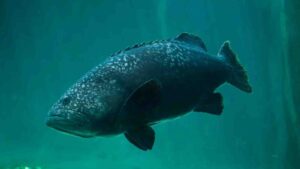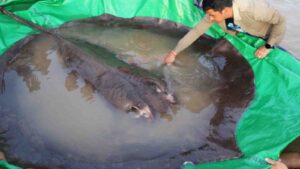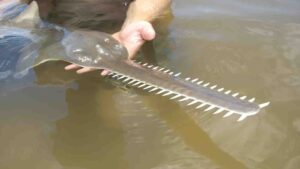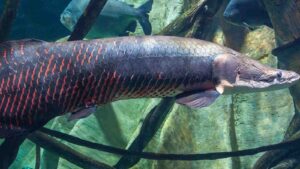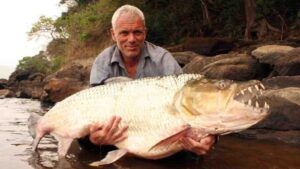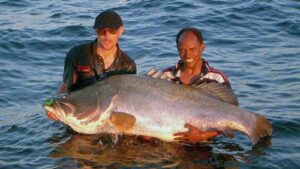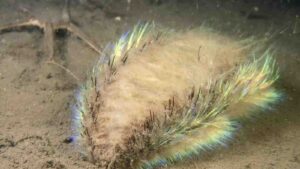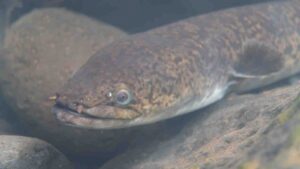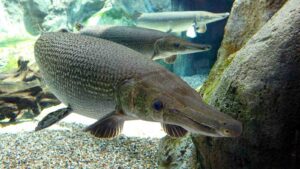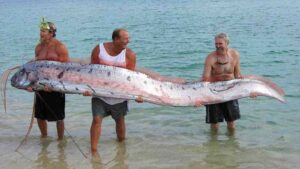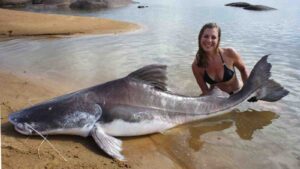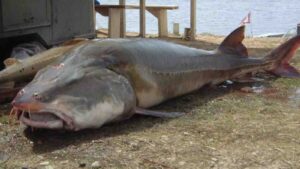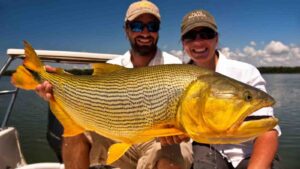Scariest River Monsters on the Planet
Summary
Top 20 Scariest River Monsters on the Planet. Every river has a story. Stories of scary river monsters are tough to get caught on camera. There are a variety of fish, which we can call the river monsters because of […]

Top 20 Scariest River Monsters on the Planet. Every river has a story. Stories of scary river monsters are tough to get caught on camera. There are a variety of fish, which we can call the river monsters because of their extremely huge size and unimaginable dangerous look. We will show you the top 20 scariest river monsters on the earth.
Video: Scariest River Monsters on the Planet
Queensland Grouper:
The Queensland grouper is the world’s largest reef-dwelling bony fish. Adults have mottled brown to dark gray stocky bodies. They are often found either hovering in mid-water or resting motionless on the substrate. A very shy fish; the larger they grow, the shyer they become. Not much is known about its spawning activity or longevity. This species is found in the Indo-Pacific and is listed as vulnerable by the International Union for Conservation of Nature.
It also enters estuaries, such as the lowermost part of the Brisbane River. It reaches up to 2.7 m in length and 400 kg in weight. Giant groupers feed on a variety of marine life, including small sharks and juvenile sea turtles.
Giant Stingray:
These ancient fish, little changed over many millions of years, can reach 16.5 feet long, including the tail. There are reports of giant stingrays weighing up to 1,300 pounds, though such accounts are not verified because weighing the enormous and awkward animals is very difficult.
Brown to gray in color, the giant stingrays are wide and flat in form, and they sport long, whip-like tails. They are known to prowl river systems in Thailand, Cambodia, Malaysia, and Indonesia, often burying themselves in sandy or silty river bottoms. This alarming river beast is breathing through holes, or spiracles, on the top of their bodies.
Video: Scariest River Monsters on the Planet
African Bull Shark:
Bull sharks get their name from their short, blunt snout, as well as their pugnacious disposition and a tendency to head-butt their prey before attacking. They are medium-size sharks with thick, stout bodies and long pectoral fins. They are gray on top and white below, and the fins have dark tips, particularly on young bull sharks.
Bull sharks are fished widely for their meat, hides, and oils, and their numbers are likely shrinking. One study has found that their average lengths have declined significantly over the past few decades.
Yacumama:
Yacumama means “mother of water,” referring to an enormous serpent believed to live in the Peruvian Amazon Rainforest. The Yacumama is believed to be the mother of all creatures of the water. According to legend, the Yacumama would suck up any living thing that passed within 100 steps of it. To protect themselves, the local indigenous peoples would blow on a conch horn before entering the water, believing that the yacumama would reveal itself if it was present. It is sometimes believed to be a giant snake or caecilian known as the Minhocão.
Sawfish:
Sawfishes, also known as carpenter sharks, are a family of rays characterized by a long, narrow, flattened rostrum, or nose extension, lined with sharp transverse teeth, arranged in a way that resembles a saw. They are among the largest fish, with some species reaching lengths of about 7–7.6 m.
Sawfish are actually docile and harmless to humans, except when captured where they can inflict serious injuries when defending themselves by thrashing the saw from side-to-side. The saw is also used in self-defense against predators such as sharks that potentially may eat sawfish.
Arapaima:
Also known as pirarucu, is a species of arapaima native to the basin of the Amazon River. Once believed to be the sole species in the genus, it is among the largest freshwater fish. The species is an obligate airbreather and needs to come to the surface regularly to gulp air.
This Amazonian monster is known for its incredible strength and lightning speed, making them a dangerous one to reel in. Wade’s first attempt with an 80-pound arapaima didn’t end so well.
Goliath Tigerfish:
This large-toothed, highly predatory fish grows to a length of 1.5 meters and a weight of 50 kilograms. Its teeth fit into distinct grooves along its jaws.
According to reporter and fisherman David Mailland, the king of all tigerfish, the largest and most famous, is Hydrocynus goliath. The people of the area call this species M’Benga, which means “the dangerous fish” in a certain language. This species lives only in the Congo Basin.
The ‘Montauk Monster’:
This bizarre-looking creature, known locally as the “Montauk Monster,” washed ashore on Long Island 10 years ago, and to this day, no one can seem to agree on what the creature’s real identity is or why the carcass mysteriously disappeared shortly after making the rounds on the internet.
With its claws, leathery skin, and beak, experts weighed in on what it could be from a raccoon to a sea turtle! William Wise of the Living Marine Resources Institute at Stony Brook University deemed it a “fake” or otherwise a “diseased dog or coyote.” There have been no other sightings of the “Montauk monster” since.
Read More: Ultimate Animals You Won’t Believe Exist
Electric Eel:
This craziest river monster has an elongated, cylindrical body, typically growing to about 2 m in length and 20 kg in weight, making them the largest species of the Gymnotiformes. Their coloration is dark gray-brown on the back and yellow or orange on the belly. Mature females have a darker color on the abdomen.
They have no scales. The mouth is square and positioned at the end of the snout. The anal fin extends the length of the body to the tip of the tail.
Nile Perch:
Large food and game fish of the family Centropomidae, found in the Nile and other rivers and lakes of Africa. A large-mouthed fish, the Nile perch is greenish or brownish above and silvery below and grows to about 1.8 m and 140 kg. It has an elongated body, a protruding lower jaw, a rounded tail, and two dorsal fins.
In 1954, L. niloticus was introduced into Lake Victoria in Africa, home to hundreds of cichlid fish. A powerful predator, the Nile perch has greatly reduced the cichlid numbers.
Goonch Catfish:
This deadliest river monster caught in the foothills of the Himalayas is a strange specimen indeed. Not only is the sheer size of this creature pretty intimidating, but this fish was also responsible for a few cases of disappearances in the area, so you know this deadliest river monster is every bit as powerful as it looks!
This fish reaches up to 2 m in length and weighs over 200 pounds. It may be the largest species in the genera.
Sea Mouse:
At first glance, this mosquito looks like an exotic species of caterpillar or an overturned porcupine, but this strange creature is far rarer—a sea mouse. The sea mouse is a rare sight in marine life circles since it usually inhabits depths of 3,000 meters below sea level in the North Atlantic, the Baltic Sea, and the Mediterranean.
This one was instead found washed up on Crosby Beach in Liverpool. Though possibly too small in appearance to qualify as a river or sea “monster,” the sea mouse is, in fact, predatory and lies in wait, burying itself in the sand before preying on small crabs and worms.
Marbled Eel:
Similar to other anguillids, the giant mottled eel is cylindrical with small, well-developed pectoral fins and a protruding lower jaw. The eel has thick, fleshy lips. The eel has dorsal and anal fins that are continuous around the tail, with the origin of the dorsal-fin origin between the pectoral fins and anus. It has small, oval-shaped scales that are embedded in the skin.
The marbled eel is carnivorous but harmless, with a wide-ranging diet, eating shrimp, crabs, bony fish, and frogs. It isnocturnal, so it is active at night.
Alligator Gar:
The alligator gar is a ray-finned euryhaline fish related to the bowfin in the infraclass Holostei. It is the largest species in the Gar family and among the largest freshwater fishes in North America. The fossil record traces its group’s existence back to the Early Cretaceous over 100 million years ago.
They have been known to survive on land for a period of time of up to 2 hours. They may be on land to look for food or to escape from predators. For the most part, they are timid, and they will run away from danger rather than aggressively attacking.
Giant Oarfish:
This scariest river monster is ribbon-like, narrow laterally, with a dorsal fin along its entire length, stubby pectoral fins, and long, oar-shaped pelvic fins, from which its common name is derived. Its coloration is silvery with dark markings, and its fins are red. Its physical characteristics and its undulating mode of swimming have led to speculation that it might be the source of many “sea serpent” sightings.
Ganges River Shark:
This river creature is a critically endangered species of requiem shark found in the Ganges River, which is the Padma River, and the Brahmaputra River of Bangladesh and India. It is often confused with the more common bull shark, which also inhabits the Ganges River and is sometimes incorrectly referred to as the Ganges shark. Unlike bull sharks, which need to migrate to saltwater to reproduce, species in the genus Glyphis are true river sharks. The genus is currently considered to contain three recent species; genetic evidence has shown that both the Borneo river shark and the Irrawaddy river shark should be regarded as synonyms of the Ganges shark, expanding the range of the species to Pakistan, Myanmar, Borneo, and Java. The species remains poorly known and very rare.
Piraiba Catfish:
It can reach over 400 lbs and is also known as the Freshwater Shark. This Amazon catfish has an elongated gray body and, apart from the long whiskers, looks just like a shark. The Paraiba is known to eat literally anything. A fisherman has found monkeys, birds, and other catfish in its stomach.
Fish of this genus are found in the Amazon, Orinoco, and Guyanas in South America. The genus does not occur west or north of the Andes or in the Venezuelan Coastal Range. These fish generally inhabit areas that have a soft substrate, such as mud or sand.
Kaluga Sturgeon:
Sturgeons aren’t normally aggressive or particularly predatory, but the Kaluga species of sturgeon, otherwise known as the “river beluga,” is in a whole other ballpark. Kaluga sturgeon are thought to be the largest freshwater fish on the planet, able to reach a maximum length of around 18 feet and can weigh up to 1,000 kg!
A normal sturgeon’s mouth is just a tube that sucks things off the bottom, but a mouth extends forward, like a catfish.
Lamprey:
This smallest river monster lives mostly in coastal and fresh waters and is found in most temperate regions except those in Africa. Some species travel significant distances in the open ocean, as evidenced by their lack of reproductive isolation between populations. Other species are found in landlocked lakes.
Adults superficially resemble eels in that they have scaleless, elongated bodies and can range from 13 to 100 cm in length. Lacking paired fins, adult lampreys have large eyes, one nostril on the top of the head, and seven-gill pores on each side of the head.
Read More: Cute Baby Animals You Need to Pet
Golden Dorado:
To spot one of these gold giants shimmering beneath your fishing boat, you could be forgiven for thinking you’d stumbled upon bars and bars of the real thing. The colossal Golden Dorado gleams like the mythical city of El Dorado it’s named after and is one of the most prized species of freshwater fish in the world.
Which one do you think is the scariest river monster? Don’t forget to let us know in the comment section.
